Ticks. EWWW! The very word gives the creepy crawlies to most of us, with very good reason! Ticks, which are second only to mosquitoes worldwide in carrying and transmitting disease, have vampire-like super powers. Ticks have super strength, super stealth, and super specialized sucking abilities to steal blood from their hosts, whether their prey are birds, reptiles, amphibians, or mammals. Ticks are hatched from eggs, and go through three more life stages (larva, nymph, and adult), and at each of these stages, they must have a blood meal, or they will perish.
There are over 800 different species of ticks, but a few of the more common ones that afflict humans and our canine companions are the hard-shelled American Dog Tick, Wood Tick, and Deer Tick.
Below are 6 super gross facts which we hope you will find enlightening:
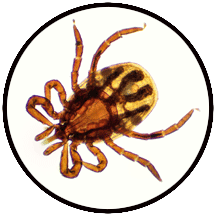
1) Super Creepy – Imagine a type of spider that craves human blood and will probably bite you, everyone you know, and even your pets at some point in your life. Ticks are classified as arachnids. Yep, that’s right – they are part of the spider family. Newly hatched tick larvae have only six legs, but grow into eight wriggly legs as a nymph and adult.
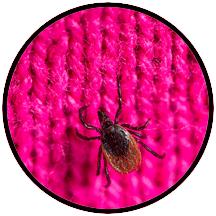
2) Super Stalkers – Instead of creating a web like their spider cousins, most hard-shelled ticks hunt for their hosts by “questing.” Ticks are apparently smart enough to identify well worn paths their prey take (e.g., deer paths, trails, etc.). There they pick a shrub or tall grasses to climb since they can’t fly or jump. They hold tightly with their third and fourth pair of legs, while they stretch out their first pair of legs, waiting for their unsuspecting prey to wander by so they are ready to latch on. And they are super patient!
Oh, and by the way, ticks don’t dive bomb from trees, apparently. They have an aversion to climbing that high without a bloody good incentive. If you find a tick on your head, they probably latched on around your ankles or calves, and climbed up from there, looking for a nice thin piece of skin with blood pulsing underneath.
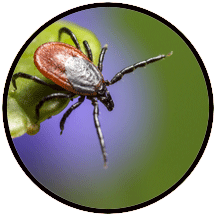
3) Super Senses – Since a tick’s quest for blood is do or die, they are equipped with super senses to detect their next meal. Those first pair of legs that are waving in the wind “questing”? Well, they have on them what are called Haller’s Organs, which are highly specialized olfactory organs that not only have a highly developed sense of smell, but can detect carbon dioxide (from breath), moisture, temperature change or body heat, and vibration. Some research has concluded that ticks can also identify shadows of their prey.
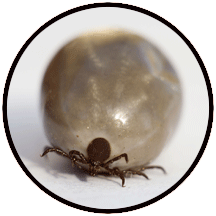
4) Super Voracious – Once ticks have landed on their victims, some may wander a bit to find their perfect picnic spot. Once they have chosen an area, perhaps a tasty ear or nice warm armpit, they settle in for a feast. As any good vampire knows, it is best not to let your victim be aware of your presence. With that in mind, ticks secrete their saliva into the host’s bloodstream. This saliva contains a neurotoxin with anesthetic properties, so the prey doesn’t feel a thing as it cuts into the surface of the skin. The tick then inserts a feeding tube (in some species, the tube is barbed) and cements it in place. Then the slow feeding begins, which can last several days in hard-shelled ticks. The University of Veterinary Medicine in Vienna studied methods of tick extraction in 2012. Because of the barbs and cement the tick uses, they recommended using a device with a V-shaped slot. The tool can be slid so that the tick’s body is at the center of the V, and the tick removed gently in one piece, mouthparts and all. This generally works well for larger, adult ticks. For some of the smaller ticks, there are other methods.
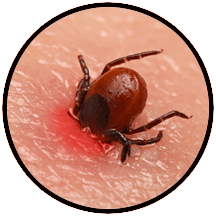
5) Super Infectious – Through their saliva, ticks pick up infectious disease such as Lyme from their hosts at one feeding, and can pass it back on at the next. In addition, if a tick is disturbed, it will regurgitate its stomach contents back into its host’s bloodstream as well (i.e., Don’t burn them with a match). This is very dangerous, as ticks can carry many different infectious pathogens, toxins, bacteria, viruses, protozoa and spirochetes that can all be transmitted with a single bite.
The CDC estimates that over 300,000 are diagnosed with Lyme disease in the U.S. every year. The actual prevalence of the disease might be much higher, due to the difficulties in diagnosing the disease. Rocky Mountain Spotted Fever, Rickettsiosis, Relapsing Fever, Babesiosis, Ehrlichiosis and Anaplasmosis are just a few of the other diseases ticks can spread.

6) Super hard to kill – Another reason that ticks are gross is their ability to survive. They will often go into a stasis when there is no food, or the temperature drops. For example, adult Brown Dog ticks can make it up to 200 days without a blood meal, while American Dog tick nymphs can last up to 584 days without food. In the winter, some ticks will go dormant if they haven’t found a good last meal in the fall. They will be in stasis until the spring, when they will re-awaken and try again. This ability is also why, during an unexpected warm day in February, you may come across a live tick or two that is thinking spring has come early.
Even the spot-on tick formulas commonly given to dogs are not 100% effective at killing ticks, not to mention that they come with serious pet health risks. This is why more and more pet owners are turning to natural alternatives to repel ticks before they bite (see below). Water does not kill them easily, even though they do not swim. Ticks have an amazingly low respiratory rate (approximately 3-15 breaths per hour) which is why they will often survive being flushed out into the sewer system. In fact, studies have been done on laundry washing to find out if ticks survive the process. It turns out, that no matter how hot the water, most ticks will survive the washing machine cycle. However, heat will desiccate them, and putting ticks in the dryer with high heat for at least 15 minutes should do the trick. Therefore, it is suggested, after a long hike in the woods, putting dirty clothes in the dryer first, and then washing them as usual.
Garlic is a natural and effective method to deter ticks:
Bug Off Garlic Chewables for Dogs
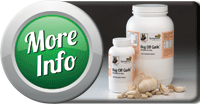
Bug Off Garlic Granules for Dogs

Bug Off Garlic Granules for Horses

Resources:
Goldberg, Carey. “Tick-Killing Tip: Dry Then Wash, Brief Dryer Spin Could Do It.” WBUR’s Common Health Reform & Reality. 1 April 2013. 5 February 2017.
http://commonhealth.legacy.wbur.org/2013/04/dryer-quick-kill-ticks
Acton, Q. Ashton, ed. Issues in Life Sciences—Bacteriology, Parasitology, and Virology: 2013 Edition. Atlanta: Scholarly Editions, 2013.
Jill. “Five Freaky Facts about Ticks.” Owlcation. 12 October 2016. 5 February 2017. https://owlcation.com/stem/Five-Freaky-Facts-About-Ticks
Centers for Disease Control and Prevention. Life Cycle of Hard Ticks that Spread Disease. 1 June 2015. 5 February 2017.
https://www.cdc.gov/ticks/life_cycle_and_hosts.html
Poldolsky, MD., Gary. Ticks Overview. 5 February 2017.
http://www.podolsky.ca/gary/TickOverview.htm
“Haller’s Organ.” Wikipedia. 18 December 2016. 5 February 2016.
https://en.wikipedia.org/wiki/Haller’s_organ
“About Lyme Disease.” Lyme Disease.Org, Advocacy, Education, & Research.
5 February 2016.
https://www.lymedisease.org/lyme-basics/lyme-disease/about-lyme/
Crystal. “Natural Tick & Lyme Disease Prevention.” Whole-Fed Homestead. 7 May 2014. 5 February 2017.
http://wholefedhomestead.com/natural-tick-lyme-disease-prevention/
|

